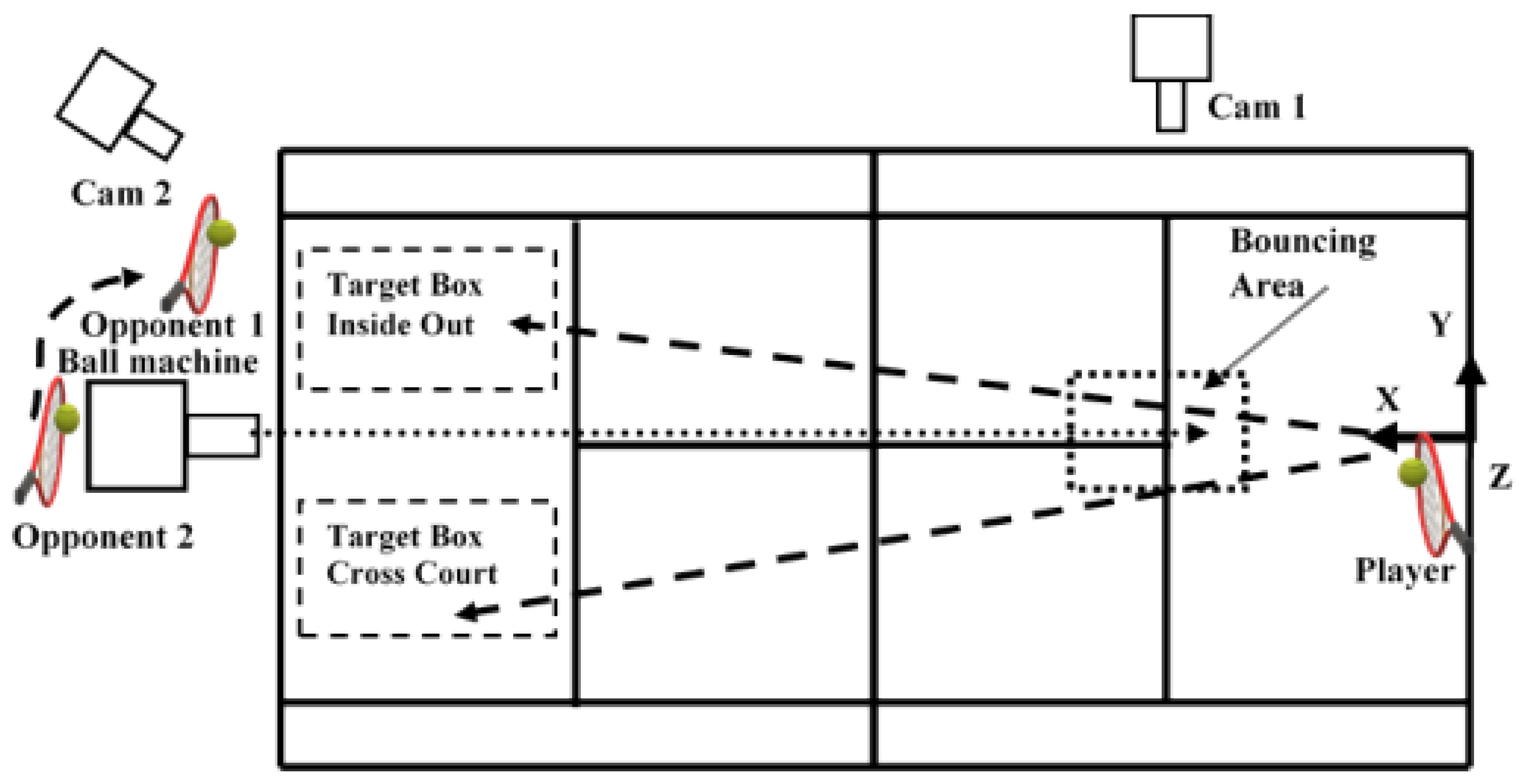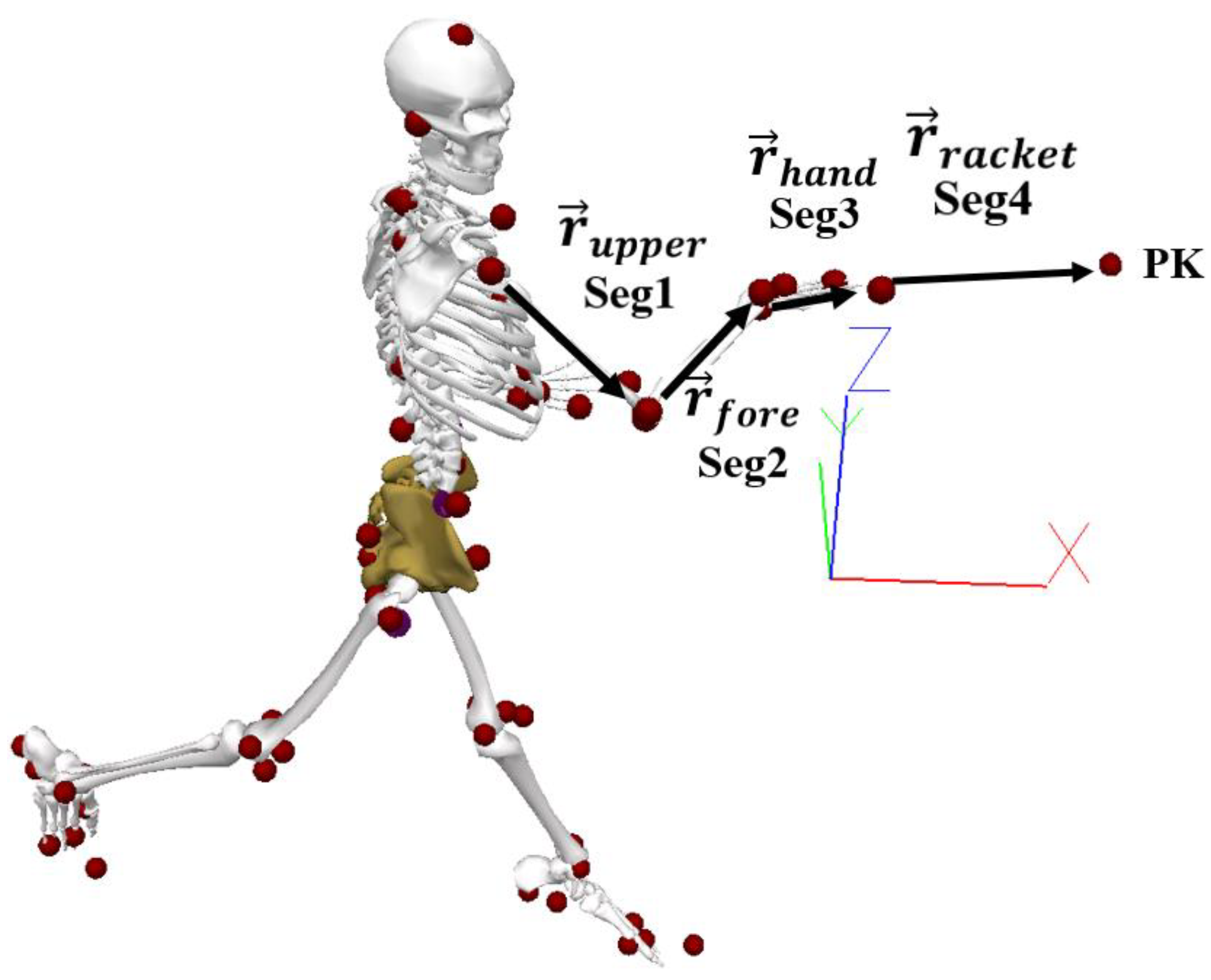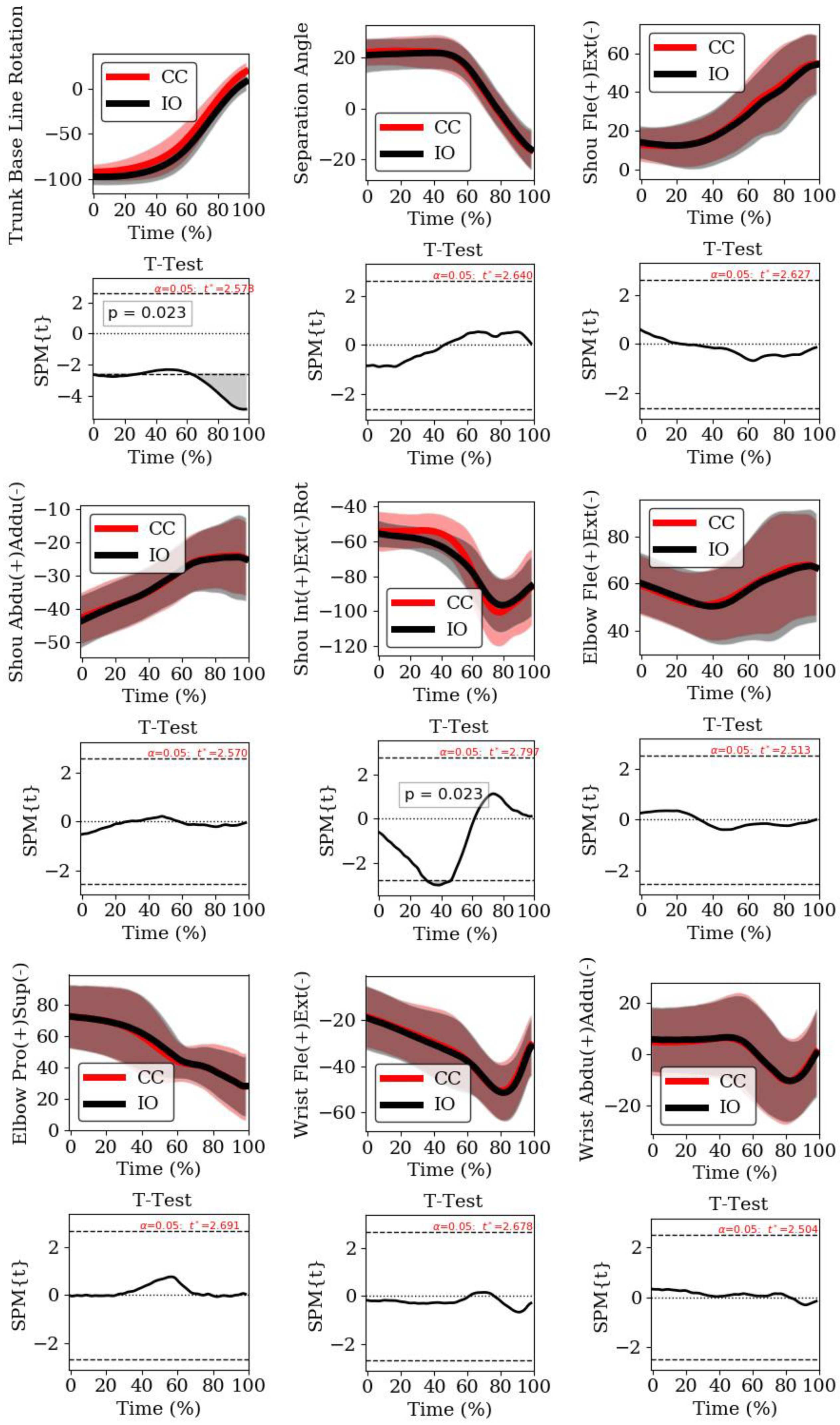Evaluation of Upper Limb Joint Contribution to Racket Head Speed in Elite Tennis Players Using IMU Sensors: Comparison between the Cross-Court and Inside-Out Attacking Forehand Drive
Abstract
1. Introduction
2. Materials and Methods
2.1. Participants
2.2. Testing Protocol
2.3. Instrumentation
2.4. Data Processing
2.5. Statistical Analyses
3. Results
4. Discussion
5. Conclusions
Author Contributions
Funding
Institutional Review Board Statement
Informed Consent Statement
Data Availability Statement
Conflicts of Interest
References
- Reid, M.; Elliott, B.; Crespo, M. Mechanics and learning practices Associated with the Tennis forehand: A review. J. Sports Sci. Med. 2013, 12, 225–231. [Google Scholar]
- Roetert, E.P.; Kovacs, M.; Knudson, D.; Groppel, J.L. Biomechanics of the Tennis Groundstrokes: Implications for Strength Training. Strength Cond. J. 2009, 31, 41–49. [Google Scholar] [CrossRef]
- Landlinger, J.; Lindinger, S.J.; Stöggl, T.; Wagner, H.; Müller, E. Kinematic differences of elite and high-performance tennis players in the cross court and down the line forehand. Sports Biomech. 2010, 9, 280–295. [Google Scholar] [CrossRef]
- Landlinger, J.; Lindinger, S.; Stöggl, T.; Wagner, H.; Müller, E. Key factors and timing patterns in the tennis forehand of different skill levels. J. Sports Sci. Med. 2010, 9, 643–651. [Google Scholar] [PubMed]
- Elliott, B.; Marsh, T.; Overheu, P. A Biomechanical Comparison of the Multisegment and Single Unit Topspin Forehand Drives in Tennis. Int. J. Sport Biomech. 1989, 5, 350–364. [Google Scholar] [CrossRef][Green Version]
- Lanzoni, I.M.; Bartolomei, S.; Di Michele, R.; Fantozzi, S. A kinematic comparison between long-line and cross-court top spin forehand in competitive table tennis players. J. Sports Sci. 2017, 36, 2637–2643. [Google Scholar] [CrossRef]
- Brabenec, J. Why the forehand is a key stroke? ITF Coach. Sport Sci Rev. 2000, 21, 11–13. [Google Scholar]
- Martin-Lorente, E.; Campos, J.; Crespo, M. The inside out forehand as a tactical pattern in men’s professional tennis. Int. J. Perform. Anal. Sport 2017, 17, 429–441. [Google Scholar] [CrossRef]
- Blandón, A.O. Diccionario Ilustrado Del Tenis [Illustrated Tennis Dictionary]; Topográficas Ltda: Bogotá, Colombia, 2008. [Google Scholar]
- Elliott, B. Biomechanics and tennis. Br. J Sports Med. 2006, 40, 392–396. [Google Scholar] [CrossRef]
- Elliott, B.C.; Marshall, R.N.; Noffal, G.J. Contributions of Upper Limb Segment Rotations during the Power Serve in Tennis. J. Appl. Biomech. 1995, 11, 433–442. [Google Scholar] [CrossRef]
- Elliott, B.; Takahashi, K.; Noffal, G. The Influence of Grip Position on Upper Limb Contributions to Racket Head Velocity in a Tennis Forehand. J. Appl. Biomech. 1997, 13, 182–196. [Google Scholar] [CrossRef][Green Version]
- Elliott, B.; Marshall, R.; Noffal, G. The role of upper limb segment rotations in the development of racket-head speed in the squash forehand. J. Sports Sci. 1996, 14, 159–165. [Google Scholar] [CrossRef] [PubMed]
- Seeley, M.K.; Funk, M.D.; Denning, W.M.; Hager, R.L.; Hopkins, J.T. Tennis forehand kinematics change as post-impact ball speed is altered. Sports Biomech. 2011, 10, 415–426. [Google Scholar] [CrossRef]
- Cappozzo, A.; Catani, F.; Della Croce, U.; Leardini, A. Position and orietnation in space of bones during movement. Clin Biomech 1995, 10, 171–178. [Google Scholar] [CrossRef]
- Roetenberg, D.; Luinge, H.; Slycke, P. Xsens MVN: Full 6DOF human motion tracking using miniature inertial sensors. Xsens Technol. 2009, 8, 1–7. [Google Scholar]
- De Vries, W.H.K.; Veeger, H.E.J.; Baten, C.T.M.; Van Der Helm, F.C.T. Magnetic distortion in motion labs, implications for validating inertial magnetic sensors. Gait Posture 2009, 29, 535–541. [Google Scholar] [CrossRef] [PubMed]
- Cuesta-Vargas, A.I.; Galán-Mercant, A.; Williams, J. The use of inertial sensors system for human motion analysis. Phys. Ther. Rev. 2010, 15, 462–473. [Google Scholar] [CrossRef]
- Pedro, B.; Cabral, S.; Veloso, A.P. Concurrent validity of an inertial measurement system in tennis forehand drive. J. Biomech. 2021, 121, 110410. [Google Scholar] [CrossRef]
- Fantozzi, S.; Giovanardi, A.; Magalhães, F.A.; Di Michele, R.; Cortesi, M.; Gatta, G. Assessment of three-dimensional joint kinematics of the upper limb during simulated swimming using wearable inertial-magnetic measurement units. J. Sports Sci. 2015, 34, 1073–1080. [Google Scholar] [CrossRef]
- Landlinger, J.; Stöggl, T.; Lindinger, S.; Wagner, H.; Müller, E. Differences in ball speed and accuracy of tennis groundstrokes between elite and high-performance players. Eur. J. Sport Sci. 2012, 12, 301–308. [Google Scholar] [CrossRef]
- Gandy, E.A.; Bondi, A.; Hogg, R.; Pigott, T.M. A preliminary investigation of the use of inertial sensing technology for the measurement of hip rotation asymmetry in horse riders. Sport Technol. 2015, 6182, 37–41. [Google Scholar] [CrossRef]
- Leardini, A.; Chiari, L.; Della Croce, U.; Cappozzo, A. Human movement analysis using stereophotogrammetry Part 3. Soft tissue artifact assessment and compensation. Gait Posture 2005, 21, 212–225. [Google Scholar] [CrossRef] [PubMed]
- MVN User Manual; Xsens Technologies B.V.: Enschede, The Netherlands, 2012.
- Grood, E.S.; Suntay, W.J. A Joint Coordinate System for the Clinical Description of Three-Dimensional Motions: Application to the Knee. J. Biomech. Eng. 1983, 105, 136–144. [Google Scholar] [CrossRef] [PubMed]
- Sprigings, E.; Marshall, R.; Elliot, B.; Jennings, L. A Three-dimensional kinematic method for determining the effectiveness of arm segment rotations in producing racqet-head speed. J Biomech. 1994, 27, 245–254. [Google Scholar] [CrossRef]
- Cohen, J. Statistical Power Analysis for the Behavioral Sciences, 2nd ed.; Lawrence Erlbaum Associates: Hillsdale, NJ, USA, 1988; ISBN 978-0-8058-0283-2. [Google Scholar]
- Pallant, J. SPSS Survival Manual: A Step by Step Guide to Data Analysis Using IBM SPSS, 4th ed.; Allen & Unwin: Crows Nest, NSW, Autralia, 2011; pp. 231–232. [Google Scholar]
- Pataky, T.C.; Robinson, M.A.; Vanrenterghem, J. Region-of-interest analyses of one-dimensional biomechanical trajectories: Bridging 0D and 1D theory, augmenting statistical power. PeerJ 2016, 4, e2652. [Google Scholar] [CrossRef]
- Pataky, T.C.; Robinson, M.A.; Vanrenterghem, J. Vector field statistical analysis of kinematic and force trajectories. J. Biomech. 2013, 46, 2394–2401. [Google Scholar] [CrossRef]
- Friston, K.J.; Holmes, A.P.; Worsley, K.J.; Poline, J.P.; Frith, C.D.; Frackowiak, R.S. Statistical parametric maps in functional imaging: A general linear approach. Hum. Brain Mapp. 1995, 2, 189–210. [Google Scholar] [CrossRef]
- Pataky, T.C.; Vanrenterghem, J.; Robinson, M.A. The probability of false positives in zero-dimensional analyses of one-dimensional kinematic, force and EMG trajectories. J. Biomech. 2016, 49, 1468–1476. [Google Scholar] [CrossRef]
- Harrison, A.J.; McErlain-Naylor, S.A.; Bradshaw, E.J.; Dai, B.; Nunome, H.; Hughes, G.T.; Kong, P.W.; Vanwanseele, B.; Vilas-Boas, J.P.; Fong, D.T.P. Recommendations for statistical analysis involving null hypothesis significance testing. Sports Biomech. 2020, 19, 561–568. [Google Scholar] [CrossRef]
- King, M.; Towler, H.; Dillon, R.; McErlain-Naylor, S. A Correlational analysis of shuttlecock speed kinematic determinants in the badminton jump smash. Appl. Sci. 2020, 10, 1248. [Google Scholar] [CrossRef]



| Variables | Cross-Court | Inside-Out | Stat. Test | p-Value | ES |
|---|---|---|---|---|---|
| Shoulder Alignment Base line | |||||
| End of backswing (°) | −92.2 ± 8.8 | −97.2 ± 8.8 * | 5.966 | 0.000 | 0.99 |
| Impact (°) | 19.3 ± 9.4 | 8.5 ± 9.4 * | −5.153 | 0.000 | −2.10 |
| Separation Angle toward dominant arm | |||||
| End of backswing (°) | 22.1 ± 4.6 | 20.9 ± 6.3 | 1.224 | 0.229 | 0.20 |
| Impact (°) | −16.5 ± 5.1 | −16.5 ± 7.1 | −0.094 | 0.925 | −0.04 |
| Shoulder Flexion (+)/extension (−) | |||||
| End of backswing (°) | 12.9 ± 8.3 | 14.1 ± 8.2 | −1.432 | 0.161 | −0.24 |
| Impact (°) | 54.7 ± 14.1 | 54.3 ± 14.6 | 0.260 | 0.796 | 0.04 |
| Shoulder Abduction (−)/adduction (+) | |||||
| End of backswing (°) | −45.1 ± 9.1 | −46.6 ± 9.0 | 1.572 | 0.125 | 0.26 |
| Impact (°) | −47.9 ± 4.6 | −47.3 ± 7.1 | −0.534 | 0.593 | −0.22 |
| Shoulder int. (+)/ext. rotation (−) | |||||
| End of backswing (°) | −54.5 ± 9.5 | −55.3 ± 8.5 | 1.112 | 0.274 | 0.19 |
| Impact (°) | −84.9 ± 18.8 | −85.5 ± 19.9 | 0.594 | 0.556 | 0.10 |
| Elbow Flexion (+)/Extension (−) | |||||
| End of backswing (°) | 59.7 ± 13.3 | 60.4 ± 13.5 | −1.062 | 0.295 | −0.18 |
| Impact (°) | 66.3 ± 18.9 | 66.4 ± 22.9 | −0.074 | 0.942 | −0.01 |
| Elbow Pronation (+)/Supination (−) | |||||
| End of backswing (°) | 72.8 ± 21.4 | 72.8 ± 21.2 | 0.027 | 0.979 | 0.00 |
| Impact (°) | 28.3 ± 23.0 | 28.3 ± 20.4 | −0.011 | 0.991 | 0.00 |
| Wrist Flexion (+)/Extension (−) | |||||
| End of backswing (°) | −18.4 ± 13.6 | −19.0 ± 14.2 | 0.496 | 0.623 | 0.08 |
| Impact (°) | −30.4 ± 13.3 | −31.3 ± 12.7 | 0.724 | 0.474 | 0.12 |
| Wrist adduction (−)/abduction (+) | |||||
| End of backswing (°) | 4.8 ± 13.7 | 5.8 ± 13.1 | −1.226 | 0.228 | −0.20 |
| Segments | Cross Court | Inside Out | |||||
|---|---|---|---|---|---|---|---|
| M (±SD) (m/s) | Contribut. (%) | M (±SD) (m/s) | Contribut. (%) | t-Test | p-Value | ES | |
| Shoulder | 2.3 ± 0.3 | 10.4 | 2.3 ± 0.5 | 10.6 | 0.158 | 0.881 | 0.06 |
| Upper Arm | |||||||
| Flex/Ext/Add/Abdu | 10.4 ± 4.6 | 48.1 | 10.0 ± 3.4 | 45.2 | 0.522 | 0.624 | 0.21 |
| Intl/Ext Rotation | 3.3 ± 2.2 | 15.6 | 3.3 ± 2.4 | 14.2 | 0.000 | 1.000 | 0.00 |
| Forearm | |||||||
| Flex/Ext | 3.7 ± 2.2 | 17.3 | 4.6 ± 3.3 | 20.9 | −1.421 | 0.215 | −0.58 |
| Pron/Supi | −0.2 ± 1.4 | −2.0 | 0.1 ± 1.1 | −0.9 | −0.488 | 0.646 | −0.20 |
| Hand | |||||||
| Flex/Ext | 1.0 ± 0.9 | 4.5 | 1.5 ± 1.7 | 5.3 | −0.162 | 0.878 | −0.07 |
| Add/Abd | 1.3 ± 1.5 | 6.1 | 1.1 ± 1.4 | 4.9 | 0.539 | 0.613 | 0.22 |
| Centre of racket | 21.8 ± 2.2 | 22.6 ± 1.8 | −0.778 | 0.472 | −0.32 | ||
Publisher’s Note: MDPI stays neutral with regard to jurisdictional claims in published maps and institutional affiliations. |
© 2022 by the authors. Licensee MDPI, Basel, Switzerland. This article is an open access article distributed under the terms and conditions of the Creative Commons Attribution (CC BY) license (https://creativecommons.org/licenses/by/4.0/).
Share and Cite
Pedro, B.; João, F.; Lara, J.P.R.; Cabral, S.; Carvalho, J.; Veloso, A.P. Evaluation of Upper Limb Joint Contribution to Racket Head Speed in Elite Tennis Players Using IMU Sensors: Comparison between the Cross-Court and Inside-Out Attacking Forehand Drive. Sensors 2022, 22, 1283. https://doi.org/10.3390/s22031283
Pedro B, João F, Lara JPR, Cabral S, Carvalho J, Veloso AP. Evaluation of Upper Limb Joint Contribution to Racket Head Speed in Elite Tennis Players Using IMU Sensors: Comparison between the Cross-Court and Inside-Out Attacking Forehand Drive. Sensors. 2022; 22(3):1283. https://doi.org/10.3390/s22031283
Chicago/Turabian StylePedro, Bruno, Filipa João, Jerusa P. R. Lara, Silvia Cabral, João Carvalho, and António P. Veloso. 2022. "Evaluation of Upper Limb Joint Contribution to Racket Head Speed in Elite Tennis Players Using IMU Sensors: Comparison between the Cross-Court and Inside-Out Attacking Forehand Drive" Sensors 22, no. 3: 1283. https://doi.org/10.3390/s22031283
APA StylePedro, B., João, F., Lara, J. P. R., Cabral, S., Carvalho, J., & Veloso, A. P. (2022). Evaluation of Upper Limb Joint Contribution to Racket Head Speed in Elite Tennis Players Using IMU Sensors: Comparison between the Cross-Court and Inside-Out Attacking Forehand Drive. Sensors, 22(3), 1283. https://doi.org/10.3390/s22031283






